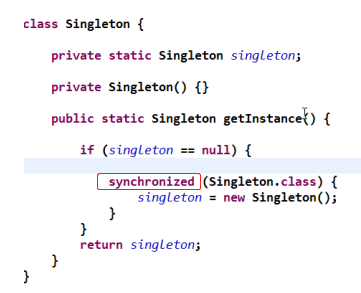| package com.atguigu.singleton.type3; |
| |
| public class SingletonTest03 { |
| |
| public static void main(String[] args) { |
| System.out.println("懒汉式1 , 线程不安全~"); |
| Singleton instance = Singleton.getInstance(); |
| Singleton instance2 = Singleton.getInstance(); |
| System.out.println(instance == instance2); |
| System.out.println("instance.hashCode=" + instance.hashCode()); |
| System.out.println("instance2.hashCode=" + instance2.hashCode()); |
| } |
| |
| } |
| |
| class Singleton { |
| private static Singleton instance; |
| |
| private Singleton() {} |
| |
| |
| |
| public static Singleton getInstance() { |
| if(instance == null) { |
| instance = new Singleton(); |
| } |
| return instance; |
| } |
| } |
| 1) 起到了Lazy Loading的效果,但是只能在单线程下使用。 |
| 2) 如果在多线程下,一个线程进入了if (singleton == null)判断语句块,还未来得及往下执行,另一个线程也通过了这个判断语句,这时便会产生多个实例。 |
| 所以在多线程环境下不可使用这种方式 |
| 3) 结论:在实际开发中,不要使用这种方式 |
| package com.atguigu.singleton.type4; |
| |
| public class SingletonTest04 { |
| |
| public static void main(String[] args) { |
| System.out.println("懒汉式2 , 线程安全~"); |
| Singleton instance = Singleton.getInstance(); |
| Singleton instance2 = Singleton.getInstance(); |
| System.out.println(instance == instance2); |
| System.out.println("instance.hashCode=" + instance.hashCode()); |
| System.out.println("instance2.hashCode=" + instance2.hashCode()); |
| } |
| |
| } |
| |
| |
| class Singleton { |
| private static Singleton instance; |
| |
| private Singleton() {} |
| |
| |
| |
| public static synchronized Singleton getInstance() { |
| if(instance == null) { |
| instance = new Singleton(); |
| } |
| return instance; |
| } |
| } |
| 1) 解决了线程不安全问题 |
| 2) 效率太低了,每个线程在想获得类的实例时候,执行getInstance()方法都要进行同步。而其实这个方法只执行一次实例化代码就够了,后面的想获得该类实例,直接return就行了。方法进行同步效率太低 |
| 3) 结论:在实际开发中,不推荐使用这种方式 |
| package com.atguigu.singleton.type5; |
| |
| public class SingletonTest05 { |
| |
| public static void main(String[] args) { |
| System.out.println("懒汉式2 , 线程安全~"); |
| Singleton instance = Singleton.getInstance(); |
| Singleton instance2 = Singleton.getInstance(); |
| System.out.println(instance == instance2); |
| System.out.println("instance.hashCode=" + instance.hashCode()); |
| System.out.println("instance2.hashCode=" + instance2.hashCode()); |
| } |
| |
| } |
| |
| |
| class Singleton { |
| private static Singleton instance; |
| |
| private Singleton() {} |
| |
| |
| |
| public static Singleton getInstance() { |
| if(instance == null) { |
| synchronized(Singleton.class){ |
| instance = new Singleton(); |
| } |
| } |
| return instance; |
| } |
| } |

| 1) 这种方式,本意是想对第四种实现方式的改进,因为前面同步方法效率太低,改为同步产生实例化的的代码块 |
| 2) 但是这种同步并不能起到线程同步的作用。跟第3种实现方式遇到的情形一致,假如一个线程进入了if (singleton == null)判断语句块,还未来得及往下执行,另一个线程也通过了这个判断语句,这时便会产生多个实例 |
| 3) 结论:在实际开发中,不能使用这种方式 |



【推荐】国内首个AI IDE,深度理解中文开发场景,立即下载体验Trae
【推荐】编程新体验,更懂你的AI,立即体验豆包MarsCode编程助手
【推荐】抖音旗下AI助手豆包,你的智能百科全书,全免费不限次数
【推荐】轻量又高性能的 SSH 工具 IShell:AI 加持,快人一步
· 阿里巴巴 QwQ-32B真的超越了 DeepSeek R-1吗?
· 10年+ .NET Coder 心语 ── 封装的思维:从隐藏、稳定开始理解其本质意义
· 【设计模式】告别冗长if-else语句:使用策略模式优化代码结构
· 字符编码:从基础到乱码解决
· 提示词工程——AI应用必不可少的技术